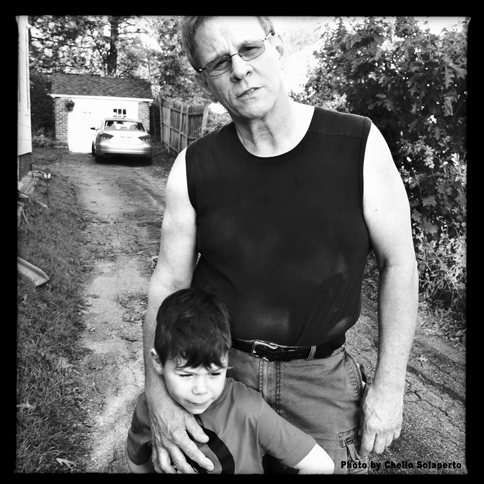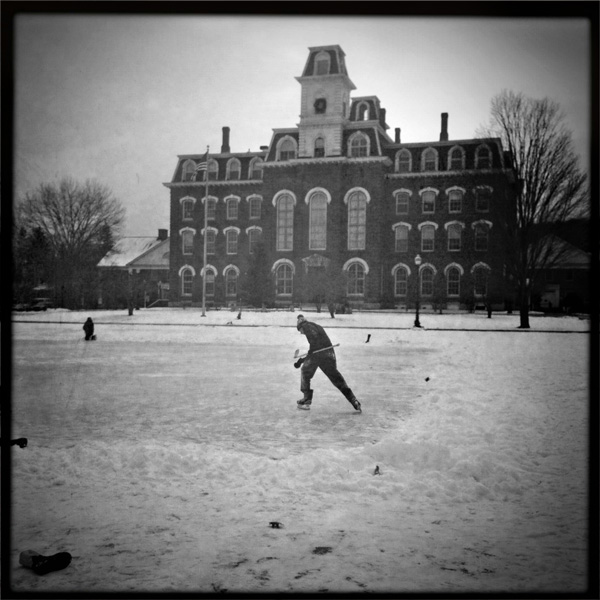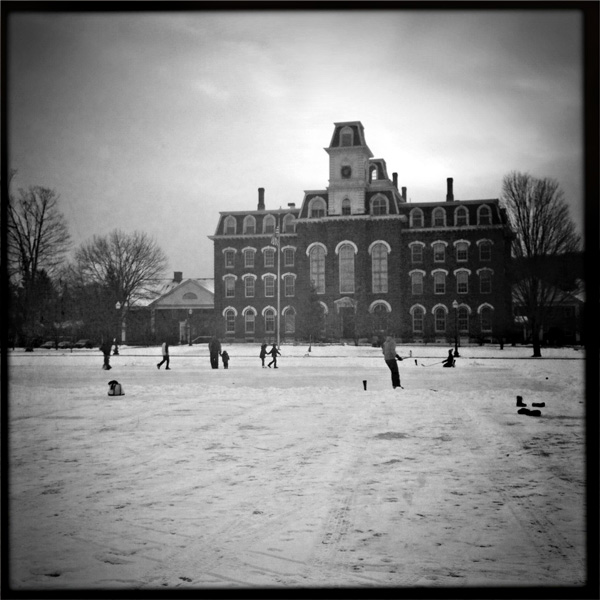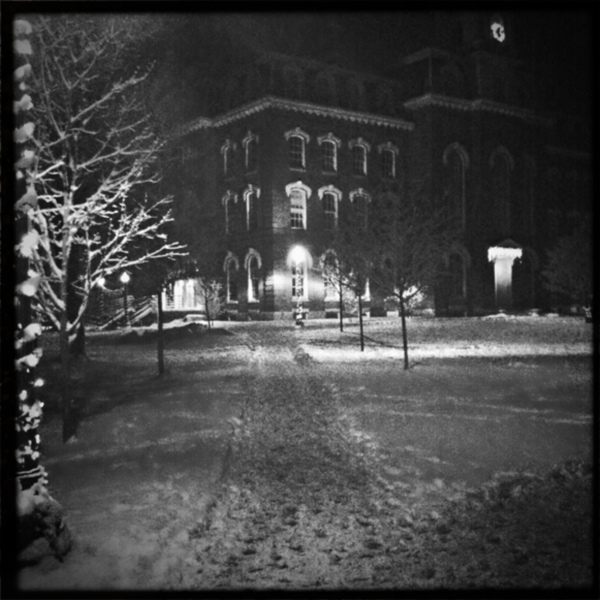Herewith stunning and mysteriously timeless photos of the Vermont College of Fine Arts green, College Hall, and Alumni Hall, caught with a smartphone camera by John Solaperto who renders the familiar strange and other-worldly, out of time. He doesn’t just snap a photograph; he completely alters our perception not only by the common techniques of framing and point of view but also by his canny and original use of black-and-white and a photo app that makes new things look old. As John aptly points out, the photos look like they date from the 1920s, but they were taken last winter. I don’t know — this stuff knocks me out; I love how art twists the neurons in my brain, and these photos do that. And, frankly, I just warm to a real, down to earth photographer who doesn’t make a fetish out of gear and renders the world beautiful with whatever comes to hand.
John is an old friend from many a VCFA residency. Some of you know him as an amiable, intense, helpful presence at lectures and public occasions. It’s a pleasure to discover his art.
dg
—–
There’s an adage among photographers that “your best camera is the one you have with you.” My experience with the camera on my smart phone over the past two or three years has really driven that home for me. I’ve limited myself to only two camera apps, but there are dozens available.
I’m particularly taken with one called Hipstamatic, which lets me choose a lens and film combination that produces a black and white image with enough pixels that I can make a decent inkjet print at approximately 6”x6”.
The configuration with which I’m shooting produces an image in a square format. The camera is set up so I can’t see the entire scene in my viewfinder. Such a configuration adds an element of chance that I like. It’s an image capture process reminiscent of the plastic cameras popular in the 1980s and 90s that used 2”x2” black and white film. One must make a lot of images to get something usable in terms of content, tone, and sharpness. This particular series of images has a rather specific target audience, namely those associated and familiar with the Vermont College of Fine Arts community. I’d like to think, however, that they also have the potential to engage a wider audience of viewers in visual narratives more specific to the context of their personal life experiences.
The two images of skaters at ground level were shot late in the day on a rather cold Sunday afternoon in late winter. They were chosen from nearly 200 exposures, made as I walked around the rink on the college green. Besides the action of the figures, the photo has a certain quality of light that I find engaging. College Hall, functioning as a backdrop, adds to the nostalgic, period quality of these images. They look as though they could have just as easily been captured in 1912.
The aerial images of skaters were shot a few days later from a second floor window of College Hall. I was aware of the figures but thought of them as secondary to the composition of the other elements of the scene, i.e. the flag, sky, tree, and light post. As it turned out, the interaction of the figures with each other provides an even stronger visual interest than the interaction of the figure with the other compositional elements. As a photographer, I feel that the image of the child with outstretched arms was an especially wonderful gift.
The aerial shot devoid of figures is included here as related to, but not really part of, the “skater series.” It was shot from the highest window I could reach in College Hall. While speaking with a colleague, I noticed the long, thin cloud or patch of fog moving rather quickly from south to north, just below the horizon. My colleague very graciously allowed me to open her office window to shoot. Of the 30 or so exposures I made to get this image, most had some part of College Hall’s architecture intruding into the composition. The one included here does not.
The night image of College Hall is an experiment in pushing the limits of available light. I think that the overall quality of light in the image, the footprints in the snow, and the diagonal motion created between the Christmas lights on the portion of the lamp post along the left edge of the image and the face in the clock tower, as well as the light in the doorway below the tower and the lamp post that lines up with the window in the center of the image, all work together to form a strong composition. The overall effect is eerie but pleasing.
All of these images represent the study of alternating patterns of light and dark tonalities. They’ve been edited with software, but not in a manner that is inconsistent with traditional dark room practice, i.e. I have made just basic tonal adjustments in all photos, and in some cases, I’ve done a lot of dodging & burning.
—John Solaperto
————————————————–
John Solaperto is a digital photographer and vocalist from Worcester, MA. He currently lives and works in Worcester, MA with his daughter and two grandsons. He is the Learning Resource Manager for the Applied Arts Program at Quinsigamond Community College and teaches Digital Photography in an adjunct capacity, evenings and online. He also spends approximately 12 weeks a year in Montpelier, VT serving as a media coordinator for Vermont College of Fine Arts’ two MFA in Writing programs and its Visual Arts program. He has an undergraduate degree from Clark University’s Studio Art Program (1993) and an MFA from VCFA’s MFA-V program (1995).







I love this series, John. And I appreciate the details you include as well. While I saw a fabulous print of the first skater image, I hadn’t seen the others. Great to see your work here!
Thank you!
Love these, John. Amazing these were shot on a smartphone. And yes… the photograph of the skaters,that photo in particular, and some of others, does look look like it could be capturing a scene from 1912.
Thanks Dominic. I enjoyed reading your manifesto here recently, although I can’t seem to locate it again for a second read…
I missed these when they were posted last December, but they are no less enjoyable now, in the middle of an odd summer. They capture something essential about the timelessness of the VCFA experience…
It’s been noted that some appear to be from the ’20s or some other earlier era, but I think it’s important to make a distinction: in no way are John’s photos, or the VCFA landscape/grain, stuck in time. These compositions, like John’s voice, seem to arrive fresh from a slower, perhaps less sullied or sullen moment, but the sense of substance and joy they bring is vital and current.
I had the opportunity to get to know John better as I prepared my lecture at this summer’s residency, and the fact that he’s full of surprises comes as no surprise.